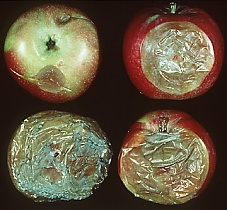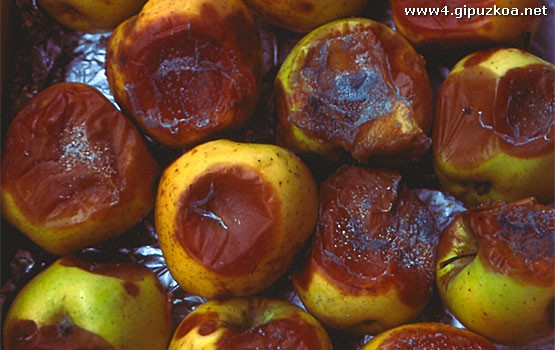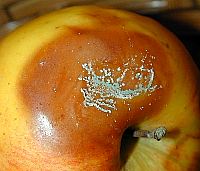|
A continuación se exponen diversos
artículos que esperamos ilustren e instruyan a nuestros lectores.
1. Penicilium (Penicillium spp)
Importancia:
Ha sido la enfermedad más importante de las causantes de podredumbre de
frutos en postcosecha, llegando a provocar cuantiosas pérdidas
económicas. Hoy en día, debido a la utilización de nuevas técnicas de
conservación, su incidencia ha disminuido en gran medida.
Síntomas y biología:
 El
hongo penetra en el fruto a través de cualquier herida o por las
lenticelas cuando los frutos llevan bastante tiempo almacenados,
circunstancia que los convierte en muy susceptibles al ataque del hongo. El
hongo penetra en el fruto a través de cualquier herida o por las
lenticelas cuando los frutos llevan bastante tiempo almacenados,
circunstancia que los convierte en muy susceptibles al ataque del hongo.
Los primeros síntomas se manifiestan por manchas marrones, blancas y
húmedas con un característico olor a moho. Esas manchas se separan
fácilmente de la parte sana y se extienden rápidamente a temperaturas de
entre 20-25º C. Posteriormente, se cubren de un micelio blanquecino que
va tornando a azul-verdoso con un aro blanco a su alrededor, por lo que
también se conoce esta enfermedad como "podredumbre azul".
Control:
No dañar los frutos en la recolección y almacenamiento; practicar
adecuadas técnicas de almacenaje; utilización de fungicidas en
postcosecha.
2. Blue Mold, Penicillium spp.
 I.
Introduction: Blue mold is the most important postharvest decay of
stored apples in the United States. The losses from this disease can be
significant but can be substantially reduced by following proper
sanitation and control measures. The fungus, Penicillium expansum, not
only causes fruit decay but also produces the carcinogenic mycotoxin
patulin. This toxin may rise to unacceptable levels in fruit destined
for processing and may also result in off flavors. I.
Introduction: Blue mold is the most important postharvest decay of
stored apples in the United States. The losses from this disease can be
significant but can be substantially reduced by following proper
sanitation and control measures. The fungus, Penicillium expansum, not
only causes fruit decay but also produces the carcinogenic mycotoxin
patulin. This toxin may rise to unacceptable levels in fruit destined
for processing and may also result in off flavors.
II. Symptoms: The appearance of the decay caused by most species of
Penicillium is very similar. The rotted areas are soft, watery and light
brown in color. The surface of older lesions may be covered by bluish-green
spores that initially are nearly snow white in color. The lesions are of
varying shades of brown, being lighter on the yellow or green varieties
and on the pale cheeks of colored varieties and showing dark shades of
brown on the most highly colored varieties. The soft, watery consistency
of the rotted tissue seems to be a more distinguishing feature than the
color variations. Two characteristics are of importance in the
recognition of P. expansum, the most common species, namely the musty
odor and the formation of conidial tufts or coremia on the surface of
well developed lesions. Under cold storage conditions, blue mold lesions
(from wound infections) caused by the common species may be expected to
be one to one and a quarter inches in diameter eight to ten weeks after
infection. In rots caused by other Penicillium species, the decayed
tissues are firmer, may lack surface growth under cold storage
conditions, and are slow-growing compared with P. expansum. The
importance of these species should not be ignored, since, it is probable
that under certain conditions, they may assume considerable importance.
 III.
Disease Cycle: The Penicillium expansum type of blue mold has been the
form most frequently reported, but a number of other less common species,
which are also usually less aggressive, have been encountered. The
positive identification of the different species that cause blue mold is
only possible by means of laboratory cultures and microscopic
examination, and even then positive determination is difficult because
of the very slight differences encountered among species. All of the
blue molds are primarily wound parasites, most frequently gaining
entrance through fresh mechanical injuries such as stem punctures,
bruises and insect injuries, finger-nail scratches by pickers, necrotic
tissues of diverse origin or through normal stems or open calyx canals.
Sometimes infections may occur through lenticels, especially when they
are damaged by cracking after a sudden abundant supply of water
following a period of dryness, or after bruising late in the storage
season when fruit have been weakened by ripening and aging. III.
Disease Cycle: The Penicillium expansum type of blue mold has been the
form most frequently reported, but a number of other less common species,
which are also usually less aggressive, have been encountered. The
positive identification of the different species that cause blue mold is
only possible by means of laboratory cultures and microscopic
examination, and even then positive determination is difficult because
of the very slight differences encountered among species. All of the
blue molds are primarily wound parasites, most frequently gaining
entrance through fresh mechanical injuries such as stem punctures,
bruises and insect injuries, finger-nail scratches by pickers, necrotic
tissues of diverse origin or through normal stems or open calyx canals.
Sometimes infections may occur through lenticels, especially when they
are damaged by cracking after a sudden abundant supply of water
following a period of dryness, or after bruising late in the storage
season when fruit have been weakened by ripening and aging.
The blue mold spores are long-lived and may easily survive from season
to season on contaminated bins, where the fungus can grow and produce
copious amounts of spores. Contamination with these spores may come from
various other sources including orchard soil carried on bins from the
orchard, decaying fruit or air. Inoculation of the fruit going into
storage is believed to occur mainly from the diphenylamine (DPA)
drenching solution used for protection against superficial scald, where
the spore concentrations increase with each successively drenched bin
and may reach high levels if solutions are not changed regularly.
Inoculation can also occur during fruit handling in water contaminated
with the fungus in packinghouses. A single decayed fruit may contain
enough spores to contaminate water on the entire packing line.
IV. Management: Postharvest treatment of fruit with fungicides has been
traditionally the most common method of combating blue mold. However,
this decay can be reduced by a variety of methods and procedures and
many of them can be combined for overall improvement. Below are the
various practices and methods that can reduce the severity of this
disease.
1.
General sanitation and avoidance of conditions favorable to
infection. The general aim of sanitary practices is to reduce the
available supply of fungal spores to the lowest possible point for
any given environment. This includes reducing contamination of bins
with orchard soil, which is a reservoir for the spores,
sterilization of contaminated bins and packing machinery, and
frequent changes of solutions and water used for drenching and
handling fruit. Fruit should be picked at the proper maturity (not
over-mature) and placed in cold storage as soon as possible. Picking
wet fruit should be avoided. Bins containing harvested fruit in an
orchard should be protected from rain so fruit will not become wet.
2. The avoidance of fruit injuries. Gentle handling of fruit by
pickers during harvesting and care during the transportation of
fruit from the orchard to the packinghouse may prevent many
injuries. Attention should be given to mechanical features of the
handling machinery in packinghouses to eliminate sources of injury
from rough corners, unnecessary drops or gravity runs, or hard or
unprotected receiving surfaces.
3. Chemical control. Killing spores in dump tanks, on bins, or in
flume water with chlorine (100 ppm) or sodium O-phenylphenate (SOPP)
(0.3 to 0.5%) has been effective in reducing the spore load and the
resulting amount of decay. Chlorine and diphenylamine (DPA) are not
compatible, so for fruit requiring DPA treatment (for superficial
scald), chlorine must be allowed to dissipate before treatment with
DPA. Ozone treatment, although not yet frequently used, can also be
effective. However, as with chlorine, ozone has no eradicant or
residual effect. Both of these treatments are most effective in
conjunction with other sanitary measures that prevent exposure of
fruit to reinoculation with fungal spores. The thiabendazoles (e.g.
Mertect 16 fl oz/100gal) are the main fungicides available to combat
decays in storage, and Captan 50W (2.5 lbs/100gal) is used to a
lesser extent. Captan has been used mainly in combination with other
fungicides because it acts as a protectant and has limited
effectiveness. In areas where fungicide resistant strains of the
fungus have developed, treatments with these fungicides may be
unsuccessful.
4. Biological control. This new method of control shows great
promise and is being studied by an increasing number of scientists
worldwide. BioSave 110 TM and Aspire (recently renamed Decco I-182)
are the two biofungicides currently available. The active
ingredients are a bacterium and a yeast, respectively. These
biocontrol agents exhibit only prophylactic activity and are not
effective against existing infections. In years with high field
infection rates, biocontrol will be most effective as a part of an
integrated control strategy which can include reduced doses (one
tenth of the recommended rate) of fungicides, calcium and heat
treatments. Good sanitary practices are also very important as the
efficacy of these methods decreases with increasing spore loads.
5. Integrated control. In addition to the already mentioned sanitary
and preventive measures taken in the orchard, the control of blue
mold may begin in the orchard with an application of calcium
chloride (2 to 6 Lb/acre), which is known to reduce Bitter pit but
may also reduce decay. Rinsing fruit before putting them through a
drencher to prevent buildup of fungal spores has been recommended.
Calcium applied to fruit by infiltration after harvest consistently
shows a significant reduction in fruit decay during storage.
Treatment of apples with hot air (38 C for 4 days) reduces decay by
killing fungal spores but it has very little or no residual effect.
This treatment also improved Golden Delicious and Gala quality in
storage. Holding fruit in hot dry air can also reduce lenticel
infection; however, additional studies are needed before final
recommendations can be made. Although postharvest apple treatment
with calcium and heat awaits commercial application, these
treatments have been shown to have additive effects in combination
with biological control in controlling blue mold on apples.
Rapid cooling and storing of fruit under CA conditions reduces the
development of blue mold. Cold temperatures have a much greater
inhibiting effect on the initiation of infection than it has on
decay development. Fruit under CA conditions maintain natural
resistance to blue mold longer than fruit placed in regular cold
storage. Maintaining proper storage temperatures and marketing fruit
before decay develops may further reduce losses.
by Wojciech Janisiewicz, USDA
Appalachian Fruit Research Station, Kearneysville, W.Va.
www.caf.wvu.edu
|
![]()
![]()